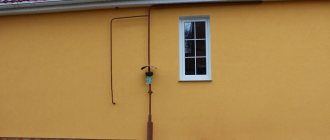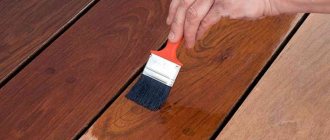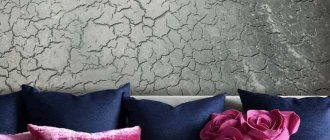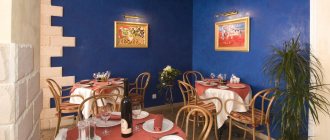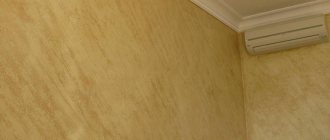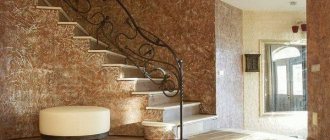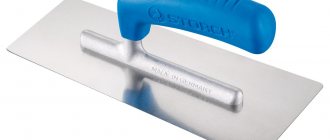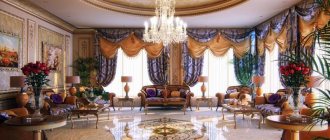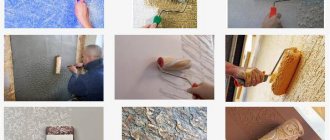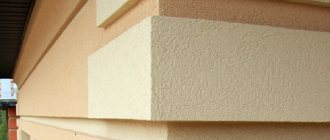Finishing load-bearing walls of buildings with facade plaster has become widespread. The application of this building material does not require qualifications or skills, and the result is a spectacular surface. The only problem is that the mixture is usually produced in a basic white color, so tinting facade plaster is now widely used. Upon completion of this work, scratches will not spoil the appearance of the object.
What paint should I use to paint the putty?
Paint
The walls in the apartment
puttied
with tinted varnishes, waxes or paints. Some plasters are offered by manufacturers tinted, while other materials are colored during the preparation process using pigments.
Interesting materials:
How to change the author's name in Word? How to change the bot name in telegram? How to change first and last name in mail? How to change administrator username and password on Mac? How can I change my name to Ali? How to change the name on a flash drive? How to change name on Macbook? How to change a character's name in Skyrim? How to change username via command line? How to change your iCloud username?
What it is
Kohler (from the Latin color - color) is a concentrated composition that is added to building mixtures to give the solution the desired shade. Available in liquid form in a wide color palette.
In addition to pastes of standard shades, there are colors with special additives that allow you to obtain metallized shiny shades: bronze, copper, silver, golden, mother-of-pearl.
Using tinting paste, decorative plaster (Venetian, bark beetle, travertine, etc.), water-based paints, enamels, whitewash and other materials are tinted. The more color added to the solution, the richer and brighter the final color. Using a small dose, light, muted shades of the coating are achieved.
Building compositions with the addition of color can be used for finishing almost any surface: brick, plaster, wood, concrete, drywall, etc.
You can purchase tinting paste in construction stores in the paint and varnish departments.
Tint pastes are added to plaster for exterior work and interior decoration. When choosing a dye, you need to take into account the operating conditions: for facades, use pigmented compounds that have increased resistance to ultraviolet radiation. This is required so that the coating does not fade over time when exposed to sunlight. For residential premises, non-toxic water-based compounds are chosen.
Popular brands of liquid colors: TEKS, Dufa, Palizh, Parade and others.
paints and varnishes
The decorative coating of bark beetles got its name due to the similarity of the resulting pattern with damage to wooden products by wood beetles. Widely used for finishing facades and decorating the interior of rooms. Plaster is distinguished not only by its appearance, but also by its excellent performance characteristics. It is resistant to temperature changes and precipitation. This article will talk about how to apply bark beetle plaster with your own hands.
Content:
Types of bark beetle plaster
There are many manufacturers on the building materials market that produce decorative bark beetle coatings. In total, there are three main types of plaster, which differ in physical properties, density of material application and resistance to external influences:
- to perform interior work;
- design of building facades;
- universal plaster.
Plaster bark beetle photo
Bark beetles also differ in the level of preparation for work:
- semi-finished product , made in the form of a suspension and packaged in plastic containers by weight;
- dry mixture with mineral granules of various diameters. Packaging: bag.
Component differences of plaster:
- acrylic plaster – has water-repellent properties. Applicable to rooms with high air humidity: basement, bathroom, shower;
- potassium silicate plaster . High level of vapor permeability and protective properties. Characterized by durability and a variety of colors;
- mineral composition - cement mixed with quartz chips. Frost-resistant and fireproof composition. Ideal for decorating facades.
- The composition of any type of plaster includes fractions of different diameters. The size range is from 0.8-3 mm and depends on the area of application: facade or interior work.
Preparing walls for applying bark beetle plaster
- Before starting work, you should decide on the plaster material. Coating with larger fractions from 2.5 to 3 mm is suitable only for finishing the facade, while chips with a diameter of 0.3-2 mm will be ideal for interior finishing.
- Next, what you should pay attention to. Bark beetle facade plaster must have increased resistance to sunlight, moisture and various types of deformation. Accordingly, the labeling must be carefully examined to confirm the intended use.
Set of tools for work:
- a bucket with a wide bottom;
- spatulas of various lengths;
- plastic grater;
- drill with a stirring attachment - “mixer”.
Surface preparation
- Clean the wall surface from dust and dirt. If necessary, degrease the surface with a special compound.
- Level the walls: remove all protruding surface elements with a spatula, and fill the recesses with putty.
- If necessary, insulate the surface with a thin layer of polystyrene foam.
Surface priming
Decorative bark beetle putty should only be applied to a thoroughly primed surface. And in this case, a standard deep penetration primer will not work. Since there is a composition for priming walls, consisting of quartz sand. It is this that allows you to obtain maximum adhesion of materials.
- drying time is 30 minutes at a temperature of +20 °C;
- consumption about 150 grams per square meter;
- the color must match the plaster.
It is important to know: the concrete base does not need to be primed. Immediately an hour before starting work, such a wall must be moistened with water to improve adhesion. The easiest and fastest way to apply the primer is with a wide roller. The compositions of modern primer materials allow application in one layer.
Preparation of a solution of decorative bark beetle plaster
The solution needs to be prepared only if you purchase a dry bark beetle mixture. The finished acrylic mass can be immediately used for its intended purpose. Preparing the dry mixture for use:
- attach the “mixer” attachment to the drill;
- Prepare a bucket half filled with water. Important: the temperature of the prepared water should be about 20 degrees;
- Next, you need to introduce the dry mixture in portions, gradually stirring with the nozzle;
- Set aside until the water is completely absorbed for five minutes and stir again at the end of the time.
Dyes (colors)
598 products found
Category
- 10
- 25
- 50
For interior work: yes
For outdoor use: yes
Packaging is more profitable! Price per pack of 6 pcs: 318 rub. Price per one. product: 53 rub. 60 rub.
Pure use: no
For interior work: yes
For outdoor use: yes
Packaging is more profitable! Price per pack of 6 pcs: 360 rub. Price per one. product: 60 rub. 72 rub.
Pure use: no
For interior work: yes
For outdoor use: yes
Packaging is more profitable! Price per pack of 6 pcs: 498 rub. Price per one. product: 83 rub. 94 rub.
Pure use: no
For interior work: yes
For outdoor use: yes
Packaging is more profitable! Price per pack of 6 pcs: 498 rub. Price per one. product: 83 rub. 94 rub.
Advantages and disadvantages of various staining methods
Each painting method is a way to implement a specific design idea. If we take the “dry brush” and “blur” techniques for comparison, then the second method is more complex in execution and is more time-consuming and physical.
To implement it, a layer of paint with a darker shade is applied to the main background of the surface, which dries for a certain time, after which the top layer is wiped off the convexities of the plaster with a damp cloth. As a result, dark paint remains only in the depressions and a three-dimensional pattern is created.
The “dry brush” technique allows you to add more “volume” to the surface. Using a brush with short bristles, light-colored paint is applied to the protrusions of the relief. In this case, a small amount of paint is collected. This method is less labor intensive.
Velatura and Via della Seta coatings add matte color to the plaster. Getting into the recesses, they make them darker, which creates additional volume.
With the help of Via Dela Seta the surface is made more velvety. If you need a pearlescent sheen, use Cadoro or Cadoro Velvet, as well as Perlacheo glaze paint. To add shimmer and more shine to the surface, it is worth using the Riflessi glaze composition. Complex effects are obtained by using several different paints.
Cork effect
The method for creating the balsa wood effect is quite simple. But you can master it if you wish. If you need to apply Venetian plaster to the walls without a professional with your own hands, it is important to realistically assess the potential. Otherwise, any rework will be very expensive.
- The effect of creating an imitation balsa wood begins with a selection of the desired colors. As a rule, there are several of them: brown, coffee with milk, gold, bright burgundy. The first layer is applied with a mixture of these colors (note that they do not need to be pre-mixed for a homogeneous mass).
- The first layer of Venetian plaster is applied quite thickly.
- The secret to creating the effect of balsa wood is to use forced drying of the Venetian. Therefore, immediately after application, we take a hair dryer in our hands and use it to dry the first thick layer of coating. At the same time, the nozzle of the hair dryer is periodically brought close, then moved away at a distance.
- When exposed to heat, Venetian plaster will crack. It is the cracks that help imitate the surface of a cork pattern.
- After treatment with a hairdryer, the wall surface is left to dry. The Venetian plaster will finally dry in two days.
- After the specified time, the second layer is applied. Water-dispersed materials are used as it. They are tinted in a different color (it is better to choose bronze or gold). Apply in a thin layer.
The surface dries for a day, then it is processed with a grinding machine. Only after this the finished Venetian plaster with a cork effect is treated with wax (it must be applied with a soft cloth). The following video clearly demonstrates the above description.
Decor options with liquid wallpaper (video)
Let's summarize. At the moment, the range of liquid wallpapers makes your eyes widen. However, you shouldn’t choose using the “finger in the sky” method, because all combinations should be in perfect harmony not only with the rest of the living space, but also, of course, with your furniture. But the most important thing is that you should like the chosen shade. If you don’t know what choice to make, contact specialists who will always help you create the color you want.
vote
Article rating
How to repaint decorative material
Before repainting decorative plaster a different color, it is not necessary to clean it of the previous shade. If it is not possible to remove the old layer, it is permissible to apply a white acrylic-based primer. The texture is preserved. After drying, you can start painting. In some cases, no primer is used. For example, if you need to lighten Venetian plaster, it is enough to cover it with a layer of pearlescent glaze.
How to remove old decorative material
Experts advise removing the old layer of putty. To do this, it must be moistened with warm water and left for 1.5-2 hours. You can use a steam generator. Then the old layer is removed using abrasive materials. The walls must be dry before further work.
Marble effect
The marble effect is created as follows:
- Using a wide spatula and sweeping movements, apply the first layer.
- After ten minutes, take a special trowel into your hands and use it to form the required relief.
- Two hours after this, a second layer is applied to the wall. It is done with a wide spatula. A multi-colored composition is laid out on it, stirred until smooth. The video lessons published in the article will tell you which colors to use to create a marble pattern. The multi-colored mass is applied to the dried first layer using pulling movements. In this case, the Venetian should lie in different directions. About five minutes after finishing the work, the applied plaster is leveled with a trowel.
- The applied layers must dry for 24 hours, then the new coating is sanded with a special grinding machine, and then polished with a stainless steel spatula. Applying wax to marble Venetian plaster helps to enhance the decorative effect.
The following video helps you see in more detail all the stages of creating the marble effect.
Tinting process
Obtaining a finished painted surface is carried out independently, for which purpose the façade plaster is tinted according to the following instructions:
- The facade is cleaned of construction debris with a rag or vacuum cleaner;
- The base is treated with a primer until completely dry;
- Color is applied. The event is carried out in small areas using an ordinary brush. The entire façade is treated with a roller. The brush is moved vertically and horizontally so that the mixture fills all the pores;
- The composition is applied with a roller in vertical stripes from bottom to top. To avoid gaps, each subsequent strip is made with an overlap on the previous one.
To plaster the facade in a monochromatic light, you need a roller and a round brush. To obtain a high-quality, distributed color, the façade plaster should be applied 2–3 strokes each. To ensure complete penetration of the color into the recesses of the textured plaster, it is applied with strong pressure on the roller.
Tinting facade plaster is the most important stage of work, which serves the aesthetic perception of the structure. Depending on the type of surface, different shades are used. The choice in favor of a specific color depends on the material, as well as its ability to transform the applied finish into the required color. The advantage of tinting is the fact that you can do this process yourself.
Preparing the surface for painting
The walls must be cleaned of dust and pellets remaining as a result of applying the plaster mixture. For smooth surfaces, use a clean cloth. For relief walls, a dampened sponge is suitable. You can also use a vacuum cleaner. Then a primer is applied to the wall.
This needs to be done in order to:
- improve adhesion of plaster and paint;
- fill small cracks in the coating;
- prevent spreading of the plaster layer.
Before you start painting, you need to protect the floor, window sill and other surfaces.
Tools for working with decorative paint
The choice of tools depends on the technique.
In most cases, masters use:
- plaster mixture (can be replaced with putty);
- paints and colors;
- foam sponges;
- brushes with different bristles;
- mixer;
- spray gun (for working with a large area);
- pieces of fabric;
- trays for varnish, paints and other compounds;
- masking tape (to highlight work areas);
- stepladder (when painting indoor walls);
- scaffolding (for working with facades).
You can use textured paint as decorative plaster. Sequins and other decorative elements are also additionally used.
